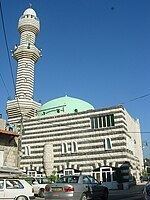Area 10 km² | Local time Sunday 10:53 PM | |
 | ||
Name meaning The village of truffles Weather 12°C, Wind SW at 6 km/h, 77% Humidity | ||
The circassian festival at kfar kama jul 2015 icca
Kfar Kama (Hebrew: כְּפַר כַּמָא, Arabic: كفر كما, Adyghe: Кфар Кама) is a town located in the Lower Galilee, Israel. In 2015 it had a population of 3,188, largely Circassian.
Contents
- The circassian festival at kfar kama jul 2015 icca
- Map of Kfar Kama Israel
- History
- Ottoman era
- British Mandate era
- 1948 and aftermath
- Notable natives and residents
- Shapsug families that live in Israel Kfar Kama
- Other families that live in Kfar Kama
- References
Map of Kfar Kama, Israel
History
Kfar Kama might be identified with a village Helenoupolis that Constantine established in honor of his mother Helen.
Excavations carried out in 1961 and 1963 revealed 4th century tombs. Two churches dated to the early 6th century, one dedicated to Saint Thecla, were uncovered, with multicolored mosaics of floral, animal and geometric patterns.
In the Crusader period it was known as Kapharchemme or Capharkeme.
Ruins and parts of five limestone columns have been found, together with a circular basalt olive-press and cisterns.
Ottoman era
In 1596, Kfar Kama appeared in Ottoman tax registers as a village in the Nahiya of Tiberias in the Liwa of Safad. It had a population of 34 Muslim households and paid taxes on wheat, barley, summercrops, cotton, and goats or beehives.
A map from Napoleon's invasion of 1799 by Pierre Jacotin showed the place, named as El Hadaci.
In the 1870s, it was described as having "basaltic stone houses, containing about 200 Moslems, situated in plain of arable soil."
The current village was founded in 1878 by 1150 Circassian immigrants from the Adyghe tribe Shapsugs who were exiled from the Caucasus by the Russians to the Ottoman Empire due to the Russian-Circassian War. Initially they made their living by raising animals, but later became farmers. The first school was established about 1880.
British Mandate era
At the time of the 1922 census of Palestine, Kfar Kama had a population of 670 Muslims and 7 Christians.
In 1945, the population comprised 660 Arabs and the land area was 8,819 dunams. Of this, 8,293 dunams were for cereals, while 108 dunams were built-up land.
1948, and aftermath
The school in the village teaches in a mixed environment of classes in Circassian, Hebrew, Arabic and English languages.
Kfar Kama is one of two Circassian villages in Israel. The other one is Rehaniya. The Circassians are Muslims, who unlike the main Israeli Arab Muslim minority, perform military service in the IDF.
A Center for Circassian Heritage is situated in the village.
Notable natives and residents
Shapsug families that live in Israel Kfar Kama
In the past there was also Shhalakhwa (Adyghe: Шхьэлахъуэ).
